#bahai house of worship
Text
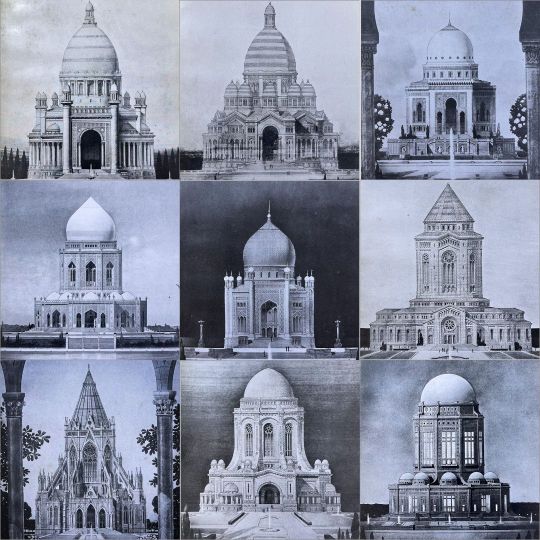
While working through our backlog of architectural books, we stumbled upon this intriguing piece of the history of the Baha’i Faith. The Baha’i Faith religion, originating in Iran in the nineteenth century, teaches the unified purpose of the major world religions. This 1917 publication details plans to construct the first Mashriqu'l-Adhkár (Baha’i house of worship) in the United States of America.

Bookplate of Charles Mason Remey
Charles Mason Remey (1874-1974) was an American architect who grew up in the Midwest and trained at Cornell and the École des Beaux-Arts. While studying in Paris, he learned about the Baha'i Faith from May Maxwell and became an adherent of the faith in 1899.
When Charles Mason Remey was making plans to construct the first American Baha’i temple, he didn’t have much in the way of precedent to guide him. At the time of publication in 1917, the first and only other temple in Ashgabat, Turkmenistan, was still two years away from completion. The Baha’i faithful had already settled on the location of the American temple in Wilmette, Illinois; in 1912, ʻAbdu'l-Bahá himself laid the cornerstone.
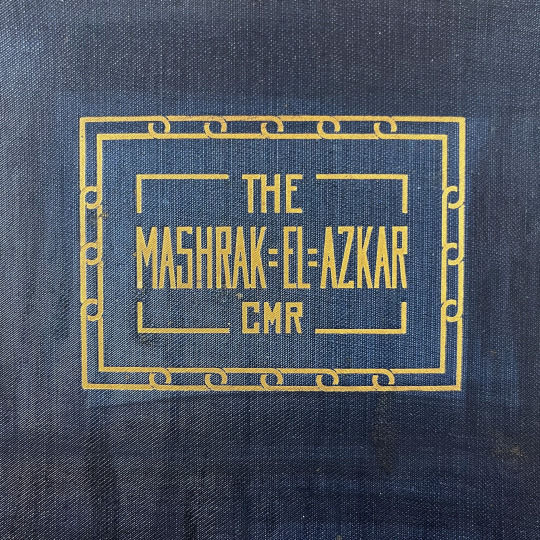
Front cover design
Remey put forth a variety of design styles for the house of worship, but one element–the repetition of the number nine–remained consistent. Why the number nine? In the Abjad numerical system in which Arabic letters correspond to numeric values, the letters in the word “baha” add up to nine. The founder of the Baha’i Faith, Ḥusayn-ʻAlí, took on the Arabic title “Baha” which translates to “glory” in English. Therefore, the number nine holds a sacred significance for members of the Baha’i Faith.
Charles Mason Remey even went so far as to propose nine different architectural styles for the American temple: Classical Roman, Byzantine, Arabian, Persian, Indian, Romanesque, Gothic, Renaissance, and Modern.
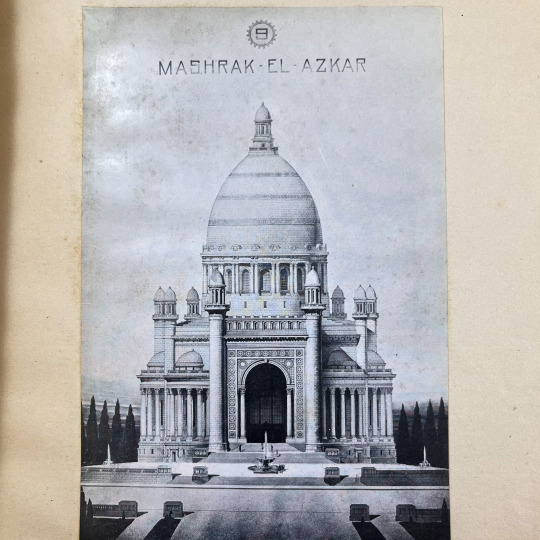
Style: Classical Roman
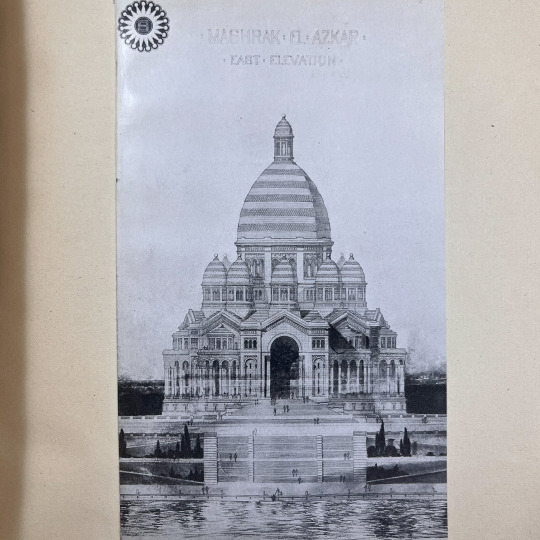
Style: Byzantine

Style: Arabian
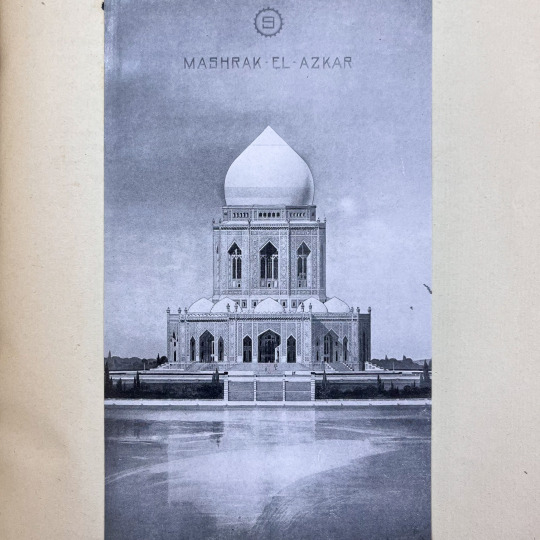
Style: Persian

Style: Indian
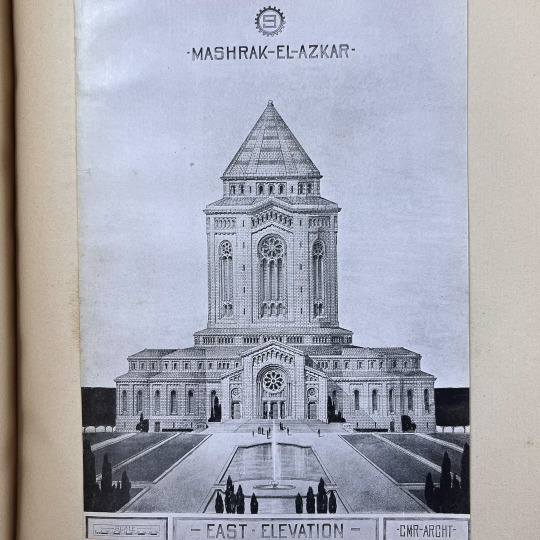
Style: Romanesque

Style: Gothic
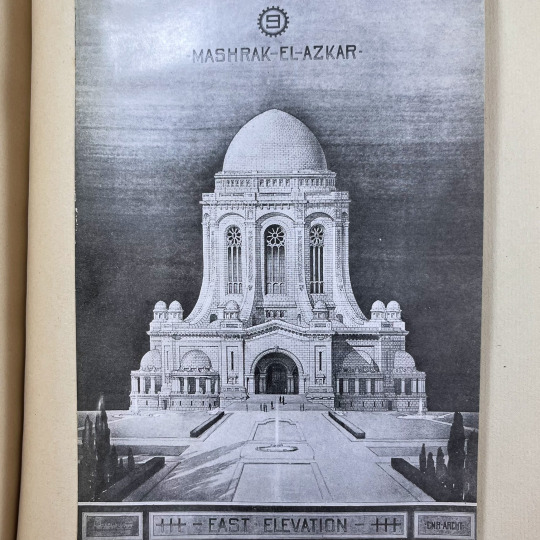
Style: Renaissance
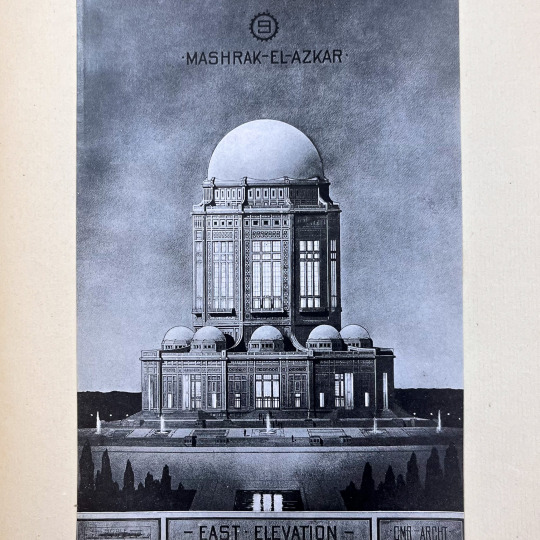
Style: Modern
In the end, Baha’i leaders went with the design of French-Canadian architect Louis Bourgeois; the Wilmette, IL, Mashriqu'l-Adhkár was completed in 1953 and still stands today. Remey did go on to build Baha’i temples in Kampala, Uganda, and Sydney, Australia, as well as the Baha’i International Archives building in Haifa, Israel. In 1960, after proclaiming himself the Guardian or the head of the Baha’i governing body, Remey was excommunicated and led a splinter group of followers for the remainder of his life.
Images from:
Remey, Charles Mason. Mashrak-el-Azkar: Descriptive of the Bahai Temple and Illustrative of an Exhibition of Preliminary Designs for the first Mashrak-el-Azkar to be built in America. Chicago: Bahai Publishing Society, 1917. Catalog record: http://bit.ly/3BfICj9
48 notes
·
View notes
Photo
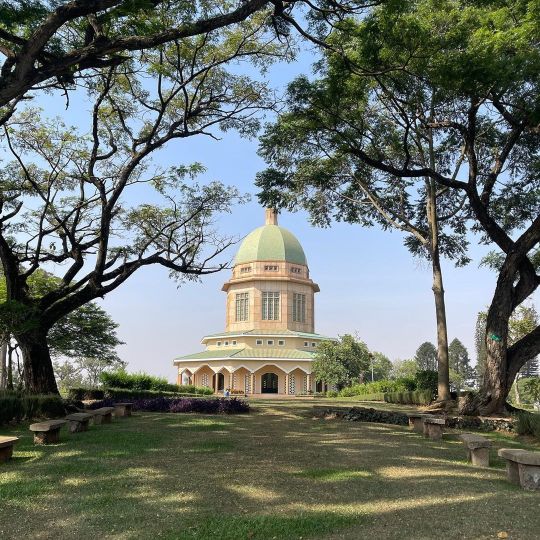
The first Bahá’í House of Worship on the African continent, completed in 1961, is in Kampala, Uganda and has become a well-known landmark. Bahá’í Houses of Worship are spiritual gathering places open to all peoples. It was far from easy to get here. I took a bus from Kenya to Uganda over night, with multiple delays and had to switch hotels three times. But I was able to make it and listen to prayers and choir and meet locals. The stories have been touching and at times funny. One story was the Ugandans were skeptical of the Temple and rumored it had ghosts. There are no ghosts, but it is a very spiritual and peaceful place to visit so please go if you can. #bahai #bahaitemple #bahaihouseofworship #Uganda #kampala #africa #solofemaletravel #solotravel #travel #sightsee #femaletraveler #travelblog #nofilter #nofilterneeded (at Bahá'í House of Worship - Uganda) https://www.instagram.com/p/Co4bSsVtZcg/?igshid=NGJjMDIxMWI=
#bahai#bahaitemple#bahaihouseofworship#uganda#kampala#africa#solofemaletravel#solotravel#travel#sightsee#femaletraveler#travelblog#nofilter#nofilterneeded
16 notes
·
View notes
Text
LOTUS TEMPLE
The Lotus Temple, located in New Delhi, India, is a Baháʼí House of Worship that was dedicated in December 1986. Notable for its lotus-like shape, it has become a prominent attraction in the city. Like all Bahá’í Houses of Worship, the Lotus Temple is open to all, regardless of religion or any other qualification.Unlike most other monuments in our country, the Lotus temple was built by Fariborz Sahba, who comes from an Iranian-American background.The architect was an Iranian, Fariborz Sahba who now lives in Canada.

There are nine entrances that open to a huge central hall, which is about 40 meters in height. The temple has a seating capacity of 1300 people and can accommodate 2500 people at a time. There are no altars or pulpits inside the Lotus Temple, which is a common feature of all Bahai Houses of Worship.

Lotus temple is situated near Nehru Place and Kalkaji Mandir metro station is just 500 meters away. The temple is in the village of Bahapur in New Delhi, National Capital Territory of Delhi
I think this place is very amazing and wonderfull. Everyone should visit this place. this place is one of the best places to visit.
3 notes
·
View notes
Text
Discovering Delhi’s Delights: Day 3 Adventures with Geniefie Trip Planner

DAY 3 DELHI EXPLORATION: SOUTH DELHI
Round off your time in the city with a relaxing day in Day 3 Delhi exoloration, South Delhi. It’s undoubtedly been an action-packed trip to the city so far, so if you’re craving a more low-key day, South Delhi is the neighbourhood for you!
This area of Delhi is a chilled-out, green, and peaceful neighbourhood, with little hassle or noise to contend with. It’s a great spot to simply head out for a walk, wander around one of the parks, people-watch on the streets, and check out one of the local cafes.
There’s also some pretty cool attractions to check out.
Kick off your explorations of this neighbourhood with an amble around the Lotus Temple, a Sydney Opera House-esque Baháʼí Place of Worship that’s open to anyone, regardless of their religious beliefs. There are just seven Bahai temples found in the world, and the white marble Lotus Temple is the only one in Asia. It’s a soothing spot, with nine turquoise pools and lush gardens to wander around.
Next, take an Uber over to Qutub Minar. A UNESCO World Heritage site, this towering minaret reaches a height of 73 metres and is surrounded by so many interesting ruins and structures.
Don’t skip this attraction! It’s far away from everywhere else in the city, but so worth venturing over to see it.
In the afternoon, if you’re not yet exhausted, head to the PVR Directors Cut cinema to watch a Bollywood movie. This is a luxury cinema in South Delhi, with comfortable chairs that recline, blankets, pillows, air purifiers, and waiters to bring meals to your seat.
WHERE TO STAY IN DELHI
Delhi is a sprawling city and there are so many options for where to stay.
I recommend opting for accommodation in South Delhi. As I’ve mentioned a couple of times already, it’s the calmer, cleaner area of the city, and you’ll be staying in a leafy suburb with less noise and a safer vibe.
I stayed in this incredible guesthouse, which absolutely made my stay in Delhi so much better. The welcoming owner did so much for us, from showing us around the local night market to driving us to tourist attractions, introducing us to his favourite breakfast spot, and even making a dozen phone calls when my SIM card wouldn’t activate. It’s one of the best guesthouses I’ve ever stayed in.
HOW TO GET AROUND DELHI
It’s so easy and so inexpensive.
You’ll likely arrive in the city just before sunrise, as that’s when most international flights seem to land, so you might be put off by tackling the public transport system. Don’t be!
I took the metro from Delhi Airport to our guesthouse in South Delhi and it couldn’t have been easier. In the early morning, it’s clean, quiet, calm, and uncrowded. There’s even a women’s-only carriage on all of the trains for all of my solo women out there.
For getting around the city, I recommend using a mix of Uber and rickshaws. Both are so easy to use and everywhere, so you’ll never have to wait long. I recommend always checking the price on Uber first, so that you have a maximum price for your journey with which to negotiate with the rickshaw drivers. It’s super-inexpensive! I paid just $7 for an hour-long Uber ride across Delhi. When it’s that affordable, there’s no reason not to use it.
WHEN’S THE BEST TIME TO VISIT DELHI?
For the majority of my India posts, you’re going to notice that I recommend visiting in winter, but for Delhi, I think early-or-late-winter would be the best time to visit.
At this time of year, you’re going to avoid the dense fog that rolls in every morning, there won’t be as much smog and pollution in the air, and the temperatures will still be manageable. I’d aim for October/November or February/March. Definitely avoid visiting immediately after Diwali, when the air pollution is always horrendous.
I’d also recommend double-checking when all of the attractions are open. The Lotus Temple is closed, for example, every Monday.
WHAT ABOUT DELHI BELLY, THO?
Delhi Belly: my biggest fear. I was absolutely convinced I would get food poisoning in India, because doesn’t it happen to everyone?
And yet, it didn’t. Despite eating pretty much anywhere that was serving up delicious-looking food, neither I nor my boyfriend suffered from food poisoning. I believe three things helped keep us safe:
Going vegetarian! Most of the locals in India are vegetarian — the country has the lowest amount of meat consumption in the world — so we switched over to a meat-free lifestyle, too. Note that I didn’t say plant-based, because you’re also going to want to avoid most fruits and vegetables while you’re in the country, too — especially if they’re uncooked or peeled.
Hand sanitiser! Much of what gets written off as food poisoning in India is general contamination from touching surfaces with bacteria on it, and then not washing your hands and touching your mouth. I used hand sanitiser on an hourly basis and took extra care not to touch my face. I also used the hand sanitiser to sterilise any utensils at restaurants, as they could have been washed with dirty tap water.
Pudin Hara! I’m a total convert to Pudin Hara — peppermint oil capsules from India — and take them every time my stomach feels a little unsettled. You can buy them from any pharmacy when you get to India, but you can also pick them up from Amazon. I took like, a hundred tablets with me, as I took a capsule with every single meal. I fully plan on keeping a large supply of these with me whenever I travel, as they were so life-changingly great at settling my stomach. An added bonus was the deliciously minty burps that overpowered the scent of curry that was emanating from my body.
AND THAT WAS DELHI!
So, my third day exploring Delhi with Geniefie Trip Planner was an unforgettable experience that left me completely enchanted by the city. Despite my initial apprehensions, Delhi’s vibrant energy, rich history, and diverse culture captivated me from the moment I arrived. From wandering through ancient monuments to indulging in the city’s culinary delights, every moment was filled with excitement and wonder. As I bid farewell to Delhi, I couldn’t help but reflect on the countless memories made and the newfound appreciation I had for this incredible city. Delhi has truly left an indelible mark on my heart, and I wholeheartedly encourage others to explore its charms and give it the chance it deserves.
0 notes
Text
Complete Information Of Lotus Temple
Complete Information Of Lotus Temple
The Lotus Temple, also known as the Bahai House of Worship, is a magnificent architectural masterpiece located in New Delhi, India.
Introduction:
The Lotus Temple, completed in 1986, is one of the most famous symbols of the Baha’i faith and an important landmark in India. It is known for its striking and unique lotus flower-inspired design, which displays…
View On WordPress
0 notes
Text
Lotus Temple Tour, New Delhi
In the month of December, the Indian city of New Delhi saw the opening of The Lotus Temple, a Baha'i house of worship. It has become one of the city's most well-liked tourist attractions as a result of its likeness to a lotus flower. Like all other Baha'i Houses of Worship, the Lotus Temple accepts visitors of any religion or none at all and has no further entry requirements.
Some of the emperors established these temples for various purposes, while the majority did so to glorify themselves or their respective faiths. The Lotus temple, on the other hand, fulfills a completely different purpose. It is designed in the shape of a flower, which the majority of Indians see as a sacred symbol owing to its look. It serves as a symbol for everything Baha'i believers put their faith in.
The Lotus Temple, one of the seven holy structures connected to the Baha'i faith, is located in New Delhi. Similar to other Baha'i temples, it has a circular, nine-sided design. The building is composed of 27 freestanding marble petals that are arranged to form the temple's nine sides.
All Bahai Houses of Worship share the absence of altars and pulpits within, as is the case with the Lotus Temple. No sculptures, pictures, or other visuals of any type are present within. One of the most stunning features of the structure is the nine pools of water that surround the temple's petals.
Please don't hesitate to get in contact with one of our experienced Trip Counselors if you have any questions about the educational and cost-effective Lotus Temple trips we provide.

#lotus temple visit time#lotus temple tour#lotus temple timings and ticket price#visiting time of lotus temple#new delhi tour#new delhi sightseeing#new delhi city tour#new delhi tour package#new delhi tour and travels#new delhi walking tour#new delhi one day tour#trip advisor new delhi#new delhi sightseeing tour#new delhi taj mahal tour#make my trip new delhi#tour operators in new delhi#new delhi travel packages#new delhi holiday packages#Trip Counselors#Trip Planner#Tour Planner#easy trip planners#travel plan#tour and travel#solo trip#itinerary planner#plan my trip#vacation planner
0 notes
Text
Top famous monuments of Delhi
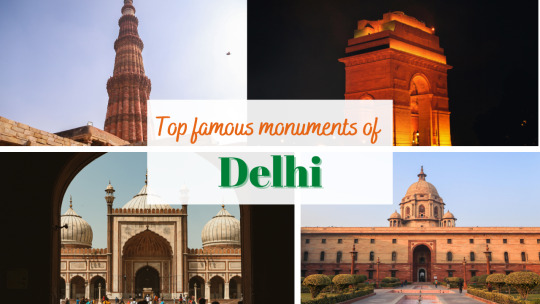
Delhi, the capital city of India, is home to some of the most iconic and historically significant monuments in the country. Here are the top monuments in Delhi:
Red Fort: A UNESCO World Heritage Site, Red Fort is a majestic fortification built by the Mughal Emperor Shah Jahan in the 17th century. It served as the residence of the Mughal Emperors for almost 200 years and is known for its beautiful architecture and intricate carvings.
Qutub Minar: Another UNESCO World Heritage Site, Qutub Minar is the tallest brick minaret in the world. Built in the 12th century, it is a masterpiece of Indo-Islamic architecture and is surrounded by several other historic structures.
Humayun's Tomb: Humayun's Tomb is a magnificent mausoleum built in the 16th century for the Mughal Emperor Humayun. It is considered to be the first garden-tomb in the Indian subcontinent and is known for its exquisite architecture and stunning gardens.
India Gate: India Gate is a war memorial located in the heart of the city. It was built to commemorate the soldiers who died in World War I and the Third Anglo-Afghan War. It is a popular spot for locals and tourists alike and is especially beautiful at night when it is lit up.
Lotus Temple: The Lotus Temple is a unique and modern temple built in the shape of a lotus flower. It is a Bahai House of Worship and is open to people of all religions. The temple is surrounded by beautiful gardens and is a must-visit for anyone traveling to Delhi.
Jama Masjid: Jama Masjid is one of the largest mosques in India and was built by the Mughal Emperor Shah Jahan in the 17th century. It is an impressive structure with a large courtyard and can accommodate up to 25,000 worshippers at a time.
Akshardham Temple: Akshardham Temple is a Hindu temple complex known for its stunning architecture and intricate carvings. It is relatively new, having been built in 2005, but has already become a popular attraction in Delhi.
These are just a few of the top monuments in Delhi. There are many more historic sites and landmarks to explore in this vibrant and fascinating city.
1 note
·
View note
Text
Dushyant Varma - Top 6 Best Places in Delhi You Must Visit
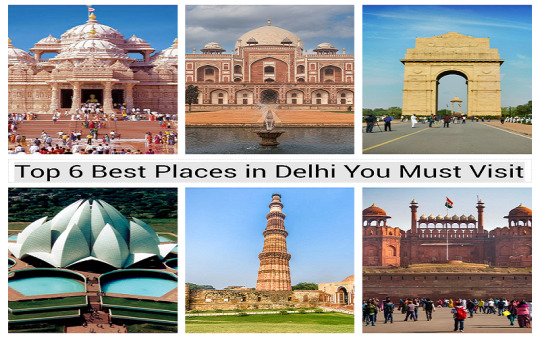
Dushyant Varma Maharani Bagh - Delhi, the capital of India, is a city filled with history, culture, and adventure. From ancient monuments to bustling markets, there is something for everyone in this vibrant city. From the iconic Red Fort to the majestic Qutub Minar and from the serene Lotus Temple to the bustling Chandni Chowk market - these places will give you an unforgettable experience. If you want to enjoy this place with your family, here are 6 of the best places to visit in Delhi according to Dushyant Varma Southern Avenue.
Akshardham Temple
Dushyant Varma Shillong says, Akshardham Temple is one of the best places to visit in Delhi, India. It is a magnificent Hindu temple complex that showcases the country's rich cultural heritage, history, and spirituality. The temple's main hall, known as the Akshardham Mandir, is a grand structure that is 141 feet tall, 316 feet wide, and 356 feet long. It is made of intricately carved sandstone and marble and has over 20,000 statues of Hindu deities, saints, and sages. The temple also has a beautiful garden called the Yogi Hraday Kamal, which is designed in the shape of a lotus and has several sculptures and fountains. It is an eco-friendly temple and promotes sustainable practices. Visiting the Akshardham Temple is an experience that you will cherish for a lifetime, and it is a perfect way to explore the spiritual and cultural side of Delhi.
Red Fort
The Red Fort, also known as Lal Qila, is an iconic symbol of India's Mughal era. It was built by the fifth Mughal emperor Shah Jahan in the 17th century and served as the palace of the Mughal emperors until 1857. The fort is a UNESCO World Heritage Site and is famous for its stunning architecture and design. The fort's main attractions include the Diwan-i-Aam (Hall of Public Audience), Diwan-i-Khas (Hall of Private Audience), and the Nahr-i-Bihisht (Stream of Paradise).
Qutub Minar
The Qutub Minar is a towering monument that stands at 73 meters tall and is one of the tallest minarets in the world. It was built by Qutb-ud-din Aibak in the 12th century and is located in the Mehrauli area of Delhi. The minaret is composed of red sandstone and marble and is ornately carved and inscribed. The Qutub Minar complex also houses several other historical structures, including the Quwwat-ul-Islam Mosque, the Alai Darwaza, and the Iron Pillar.
India Gate
Dushyant Varma says, The India Gate is a war memorial located in the heart of Delhi, which was built to commemorate the Indian soldiers who died during World War I. It is a popular spot for locals and tourists alike, with lush green lawns and gardens that are perfect for picnics and relaxing. The monument is 42 meters tall and is made of red sandstone and granite. At night, the India Gate is lit up beautifully, making it an ideal spot for an evening stroll.
Lotus Temple
The Lotus Temple is a stunning modern structure that is shaped like a lotus flower and is a Bahai House of Worship. It is located in the southern part of Delhi and is famous for its unique design and peaceful atmosphere. The temple is made of white marble and has 27 free-standing petals that are arranged in clusters of three to form nine sides. The Lotus Temple is open to people of all religions and is a great place for meditation and contemplation.
Humayun's TombAccording to Dushyant Varma Maharani Bagh, Humayun's Tomb is a stunning example of Mughal architecture and was built in the 16th century by the widow of the second Mughal emperor, Humayun. The tomb is located in the Nizamuddin East area of Delhi and is a UNESCO World Heritage Site. It is made of red sandstone and white marble and has several gardens, water channels, and fountains. The tomb is a beautiful spot for photography and is a must-visit for history buffs.
1 note
·
View note
Text
"Discovering Delhi: Exploring the Best of India's Capital with Logitrust Voyages
Welcome to Delhi, the bustling capital city of India, where history and modernity coexist in a mesmerizing blend. And what better way to explore this dynamic city than with Logitrust Voyages, your trusted travel partner? With Logitrust Voyages, you can be sure to have an unforgettable experience discovering Delhi's best sights, sounds, and tastes.

One of the first things you'll notice about Delhi is its rich history, and Logitrust Voyages will take you on a journey through time, starting with the Red Fort. This stunning monument was once the seat of the Mughal Empire and is now a UNESCO World Heritage Site. As you explore its magnificent halls and courtyards, you'll feel transported to another era.
Next up, you'll visit the Jama Masjid, one of the largest mosques in India, with a capacity to hold over 25,000 worshippers. Its intricate architecture and design are a testament to the country's Islamic heritage.
Delhi is also known for its vibrant street markets, and Logitrust Voyages will take you to the heart of the action. At Chandni Chowk, you'll find everything from colorful fabrics to mouth-watering street food. The market's chaotic energy is contagious, and you'll find yourself bargaining with vendors for hours.
No trip to Delhi is complete without sampling its rich cuisine, and Logitrust Voyages knows all the best spots. From the spicy chaat to the buttery naan, you'll savor every bite of the city's famous dishes. And for dessert, try the creamy kulfi or the delicate rasgulla.
As the sun sets on Delhi, Logitrust Voyages will take you to the Lotus Temple, a unique and stunning Bahai house of worship. The temple's serene atmosphere and architectural beauty make it the perfect place to reflect and unwind after a long day of exploring.
With Logitrust Voyages, discovering Delhi is an adventure you won't want to miss. From the city's ancient history to its modern-day wonders, there's something for everyone. So pack your bags and join us on an unforgettable journey through the best of India's capital city.
0 notes
Text
"Architectural Marvels of Delhi NCR: A Glimpse into Archihives.co.in's Stunning Portfolio"
Delhi NCR, the bustling metropolitan region of India, is known for its rich cultural heritage, diverse population, and thriving economy. Amidst the city's chaos and hustle-bustle, there are several architectural marvels that are worth exploring. The team at Archihives.co.in has been capturing these magnificent structures for years, and in this blog post, we'll take a closer look at some of their work.
Archihives.co.in is a renowned photography and design studio that specializes in capturing and showcasing the best of architecture and design in India. Their portfolio includes a wide range of projects, from residential and commercial buildings to public spaces and cultural landmarks. Let's take a closer look at some of their work in Delhi NCR.
One of the most iconic buildings in Delhi NCR is the Lotus Temple, which is also known as the Bahai House of Worship. Archihives.co.in's photographs of this building beautifully capture the temple's intricate design, which resembles a lotus flower. The building's white marble exterior and surrounding gardens provide a stunning backdrop for photographs.
Another notable building that Archihives.co.in has captured is the Akshardham Temple in Delhi. This massive Hindu temple complex features stunning architecture and intricate carvings that are a true feast for the eyes. Archihives.co.in's photographs capture the grandeur of this temple and its beautiful surroundings.
Archihives.co.in has also captured several modern buildings in Delhi NCR that showcase the city's contemporary architecture. The DLF Cyber Hub in Gurugram is a prime example of this. The building's sleek design and vibrant colors make it a popular spot for photography, and Archihives.co.in's photographs of the building perfectly capture its energy and vitality.
In addition to buildings, Archihives.co.in has also captured several public spaces in Delhi NCR, such as the India Gate and the Qutub Minar. These landmarks are steeped in history and are important cultural symbols in the city. Archihives.co.in's photographs of these spaces beautifully capture their grandeur and magnificence.
In conclusion, Archihives.co.in's photographs of architecture in Delhi NCR provide a fascinating glimpse into the city's rich cultural heritage and contemporary architecture. Their work showcases the beauty and diversity of the city's buildings and public spaces and highlights the importance of architecture in shaping our urban landscapes. Whether you're a lover of architecture, design, or photography, Archihives.co.in's portfolio is sure to captivate and inspire you.
0 notes
Text
Talking about Delhi ❤❤
The thing I found most fascinating about Delhi is how vibrant everything is there is—from the food to the people. 🍕🍔🍟👩🏻⚕️👩🏻🌾👩🏻🍳
If Delhi is the heart of the country, then its heart beat is always racing. There is no possible way to escape the energy that Delhi's countless attractions bring with them. Well, the country's capital also serves as a hub for positive developments. From historical monuments to street food. The top coliving residences to the finest colleges.
Let's discuss about Interesting Facts About Delhi You Should Know.
The Red Fort was Originally White
Red Fort is one of the best things about Delhi, especially if you love history. But did you know this monument was not always red in colour? According to the Archaeological Survey of India, it was actually made of white limestone and when the colour started chipping off, some British officials decided to paint it red.

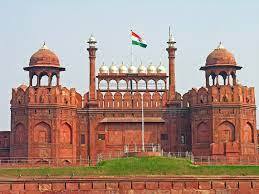
Tallest Minaret in the World
If you search for information about New Delhi on the internet, you won’t find a single place that doesn’t mention Qutub Minar. After all, it is not only a special historical monument but also the tallest brick minaret in the whole world. It was built way back in 1200 AD, but the Minar stands “tall” even today.
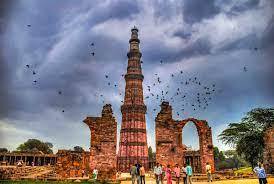
Asia’s Largest Spice Market
Even though it’s situated really close to the Red Fort, there are high chances that you might not have heard of this one. Khari Baoli, Asia’s largest spice market, started somewhere in the 17th century and continues to be a bubbly marketplace to date. Do visit this market if you want to spice up your food (or your knowledge about Delhi). Quite literally.
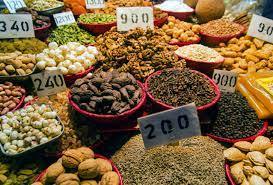

Asia’s Largest Wholesale Market for Fruit and Vegetables
Speaking of Asia’s largest markets, Delhi has another one of them. The Azadpur wholesale is the largest fruit and vegetable market in all of Asia. If you love fruits, this is the place to be. From local produce to international varieties of kiwi, Alphonso mango, peach, you will find everything here. And for the ones who have chosen the organic life, you’ll find plenty of options too. Just for a few extra bucks.

Only Bahai Temple in Asia
If you already didn’t know this about Delhi, let us tell you that the city houses the only temple dedicated to the Baha’i religion in Asia. In fact, Lotus Temple is one of the eight Bahai temples in the entire world. It’s open to people of all religions and is no longer just a place of worship anymore. It’s a place you can come to meditate, date or simply take some aesthetic pictures.

#travelling#india#delhi#redfort#qutubminar#asia#largest#spices#market#wholesale marketplace#fruits#vegetables#bahai relegion#temple#lotus temple#socialbee
0 notes
Photo
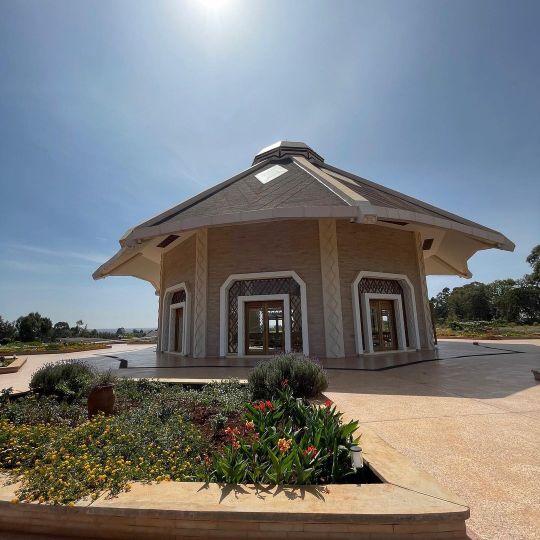
The first local Bahá’í House of Worship in the continent of Africa opened in Matunda Soy, Kenya in 2021 and is open to all peoples, and is a place where prayer and contemplation inspire service to society. The local Temple was completed in just three years. The Bahai governing body, The Universal House of Justice stated this “is a testament to the vitality, resourcefulness, and determination of the Kenyan people.” I took a 5+ hour bus from Nairobi to Elderot and got a driver to take me 1.5 hours to the Temple. I am happy to have been able to go to my second local Bahai Temple. #bahai #bahaitemple #bahaihouseofworship #kenya #africa #solofemaletravel #solotravel #travel #sightsee #femaletraveler #travelblog (at Matunda) https://www.instagram.com/p/Co4aHTot3tN/?igshid=NGJjMDIxMWI=
#bahai#bahaitemple#bahaihouseofworship#kenya#africa#solofemaletravel#solotravel#travel#sightsee#femaletraveler#travelblog
1 note
·
View note
Photo
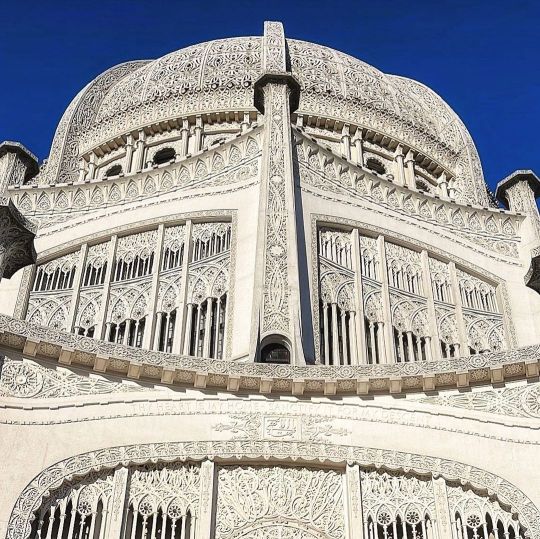
Constructed to serve all of North America, it is the second Baháʼí House of Worship ever and the oldest one still standing. Ironically, it was designed by the French-Canadian architect Louis Bourgeois. • • • #chicagoland #igerschicago #usa #illinois #wilmetteillinois #louisbourgeois #lookup #bahai #baháí #bahaifaith #temple #nationalregisterofhistoricplaces #cookcounty #architecture (at Baha'i House of Worship for North America) https://www.instagram.com/p/CoDoh83P-nz/?igshid=NGJjMDIxMWI=
#chicagoland#igerschicago#usa#illinois#wilmetteillinois#louisbourgeois#lookup#bahai#baháí#bahaifaith#temple#nationalregisterofhistoricplaces#cookcounty#architecture
1 note
·
View note
Text
Heya.
I’d like to state that I would certainly be a disappointment as a guru or spiritual practitioner. If you are Christian and wish to be more open Baha’i people learn from all world religions and are Christian similar to druidic practice. If I was Christian that would be where I would be if even just for the please toss my body in a hole at my house and be done with it... strange and legal funeral, only and specifically for Bahai I think. A Klingon rite haha. She, a Baha’i, was my best friend at 17 when I left the nest; spent 1-2 years smoking and drinking coffee all night at the Denny’s, she formed more of my current beliefs than did the first 14 years of my life as LDS and she has also influenced me later in life. Helped me become slightly less naive. She has a mosquito tattoo maybe because the existence of a entity as thoroughly irritating parasitic and useless says something about god and reality, it’s seems maybe anti-Daoism, she would ask as if you really feel kinship to Trump who has absolutely no human value and yet supposedly is just another us in a different washing machine at another time. Fierce human being and honestly a harder hitter than me spiritually. Has a deaf child which has given me a curiosity towards sense disabled people I've never been able to entertain. She is a writer/teacher hardcore punk. My wife in some other life where I didn’t leave rural Oregon. (Maybe, but definitely first soulmate)
Religion/spiritual studies follow definitely skip-able just leaving access if anyone wants to know.
I have an affinity to Shinto because it’s warm bubbly paganism without any specific carnal or violence worship. Modern Shinto is for me hayao miyasaki on the positives and mushishi on the destructive, it’s acceptable stories for children to learn how to coexist in a ecosystem and the scientist bits of me approve and there’s no doctrine which is why I am openly recommending it as it is entirely non hostile and about coexistence. Shinto does believe one obvious principle that Kami pervades all things like us in that radishes are essential of the same stuff. This feels like what I learned from shaman type journeys.
I fibbed before when I said I blame objects I did that specifically to elicit a response in opposition as I want you to be on the side of your stuff as you should want to protect sacred things and have that state of mind. That rare use of false manipulation was slightly premeditated, but it is a unusual thing for me and it was done intuitively. I like to believe stuff can have magic in it. I think the guru/teacher archetype is hard wired in all of us but my relationship to that part of me is not one trained to nor would recommend to others but for fun and enjoyment of being aliveness.
The original Kino’s Journey is a really interesting combination of Buddhism and what it is to go through living and dying and how to act ethically. Little bit like Starmaker(Olaf Stapleton) or maybe Star Trek but old school. The remake is decent additionally but i stan the original. I dislike the stodgyness of Buddhism and it seems like they washed their historical humanitarian abuse from what they claim is their origin, they also believe that abortion should not be allowed which if you believe that you can be warmer there than I feel about that. I do think they are a good thing for the world in a cognitive and modern compassionate sense. Similar to why I didn’t find to much interest it Aboriginal cultures I’ve gotten to know it’s often a old dude being traditional in a lot of cases. Every tribe is different though right.
I have weird feelings saying it, but I’m much into liberation of bonds and freedom of choice where your choices are within proper ethical standards of harm and kindness and I didn’t really realize it till my 30s how U.S. of an ideal this is. About Buddhism if you didn’t know rebirth doesn’t work the way most external parties believe of Buddhist reincarnation. Death means heaven or hell realms and what is reborn is the continuation of the causation that was your imprint or dharma and following your death that thread is continued by another entity and that is prev/next life connection. A different person. I don’t believe in heaven or hell but just the hum of matter becoming energy becoming matter again but I disbelieve more of my superstitions than I believe. I may discuss random superstitions later who knows but a lot of them are obviously caused by anecdotal patterns. (Synchronicity aka pattern match which the brain excels at)
It seemed necessary to write this, if you want faith or devotional sources I don’t currently practice those intentionally and don’t see it happening. I was into Krishna for a while, but I like worship through what is in my presence in a complete form. I like not knowing; that can be uncomfortable if you are used to faith. I think it’s mystifying and amazing that there are so many mysteries that seem to be agnostic as the only rational principle of access. I just know I’m ruled by magic of emotions and heart and the brain forges through in disregard. Curiosity and convincing yourself to try on belief is something I hope is of wider utility to the human experience. I do not believe doubt is bad for you and I feel no need to apologize if I have created it in you. Repeating the intro I’m not an answer guru nor plan to be I’m just another curious cat.
Safe Journeys
0 notes
Text
Golden Triangle Tours - Delhi Agra Jaipur Tours

The most popular travel route in northern India is the Golden Triangle. It includes three historical and historic cities in India. This fascinating travel route covers three cities: Jaipur, Agra, and Delhi. A large number of tourists travel to the golden triangle every year from all over the globe. This amazing tour in northern India offers tourists the chance to get a great insight into India's rich cultural heritage. Tourists can visit various heritage and historical monuments such as Red Fort, India Gate and Qutub Minar. This tour option in northern India offers tourists the opportunity to see a wonderful blend of modernity and ancient charm.
The capital of India, Delhi, is the starting point for the golden triangle tour. India's capital city, Delhi, is an historic and ancient city. Although it is one of the most advanced cities in the world, it still retains its historic charm. This historic city offers tourists the chance to visit many heritage and historical monuments as well as several modern attractions. It is an unforgettable experience. This city is home to three UNESCO world heritage locations. These are Qutub Minar, Red Fort (the longest brick-built minaret in India), and Humayun’s Tomb (the first Indian garden tomb). India Gate (an all-Indian war memorial monument), Old Fort, (Purani Quila), Sansad Bhawan ("Parliament of India"), President Bhawan and Lodhi Gardens, Lotus Temple (the Bahai House of Worship), Birla Temple (the largest Hindu Temple Complex), Akshardham Temple (the largest Hindu Temple Complex), Chandani Chowk and Connaught Place) are some of the most popular attractions of Delhi tourism.
Delhi Agra Jaipur Tour, the city of Taj Mahal, is the second destination in Golden triangle travel. Agra, Uttar Pradesh's beautiful town, is located along the Yamuna River. Agra, like Delhi, also has three UNESCO world heritage locations. These are the Taj Mahal and Agra Fort, as well as Fatehpur Sikri. The Taj Mahal, the symbol of love, is well-known for its architectural beauty. It attracts tourists from all over the globe for India tours. It is one of India's most popular tourist attractions. It is also listed as one of the Seven Wonders of the World. This love monument, a beautiful representation of the union between Shah Jahan and Mumtaz Mahal, was constructed in loving memory of Shah Jahan, mughal emperor. The view from Taj Mahal's white marble monument is breathtaking, especially at sunset and full moon. The architectural beauty of Agra Fort is a testament to Akbar, the mughal emperor, who built it. Itmad-Ud-Daullah Tob was built in memory of her father by Noor Jahan, mughal empress. It is also known as the Baby Taj, the Little Taj Mahal, or the Draft of the Taj Mahal. Agra tours will be a great choice.
The third and final destination on the exciting Golden Triangle Tours is Jaipur, India's pink city. It is Rajasthan's capital and is known for its magnificent forts and palaces, havelis and temples, gardens, and heritage hotels. Jaipur tourism features include the City Palace, Hawa Mahal and Jal Mahal, Amber Forts, Jantar Mantars, Jaigarh Forts, Nahargarh Forts, Albert Hall Museum, Rambagh Palace, and many other attractions. This India tour package will make you fall in love with the charming city of Delhi Agra Jaipur. Come and discover these historical Indian cities and have the experience of a lifetime.
0 notes
Photo
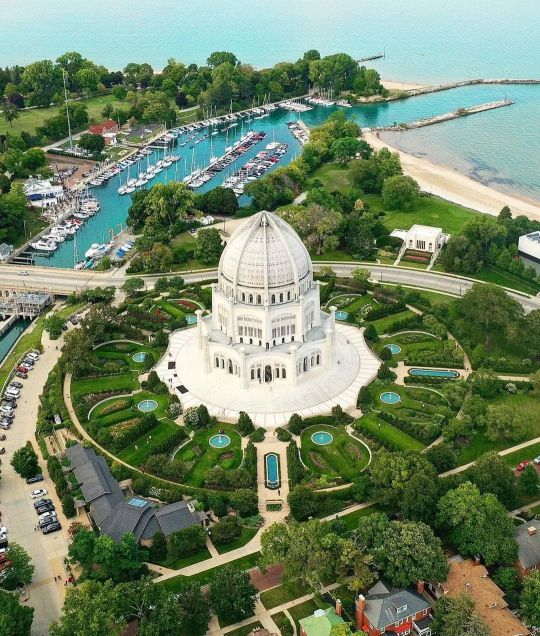
When the landscape is still so green . . . . . . . . . . . . . . . . . . . Credit 👉🏆📸 @jennylichao . . . Follow 👉 🇺🇸@conexao.america for more photos and movies about United States 🇺🇸 . . . . Alliance @america_states @enjoy_la_ @latinbrazil . . . ✈ Mark your photo with tag #conexaoamerica or @conexao.america and we'll post it! . . . #dronephotography#enjoyillinois#onlyinillinois#ciaodrone#chicago#epic#chicagoexplore#chicagophotographer#secretchicago#droneillinois#amazingdroneshots#city_features#citykillerz#bahaitemplechicago#igerschicago#onlyinillinois#chitecture#bahai#bahaifaith#lifeviachicago#lifeatchicago#lifeofchicago#summer#usatravel#conexaoamerica (em Baha'i House of Worship for North America) https://www.instagram.com/p/Ci7TsesOLOE/?igshid=NGJjMDIxMWI=
#conexaoamerica#dronephotography#enjoyillinois#onlyinillinois#ciaodrone#chicago#epic#chicagoexplore#chicagophotographer#secretchicago#droneillinois#amazingdroneshots#city_features#citykillerz#bahaitemplechicago#igerschicago#chitecture#bahai#bahaifaith#lifeviachicago#lifeatchicago#lifeofchicago#summer#usatravel
0 notes